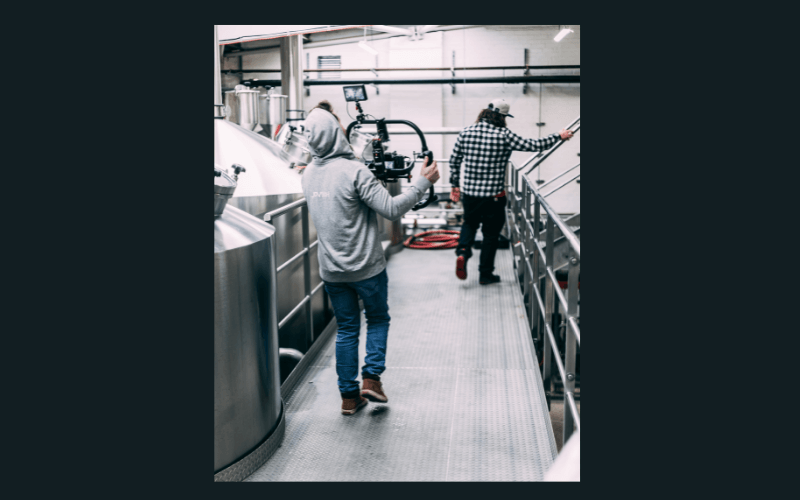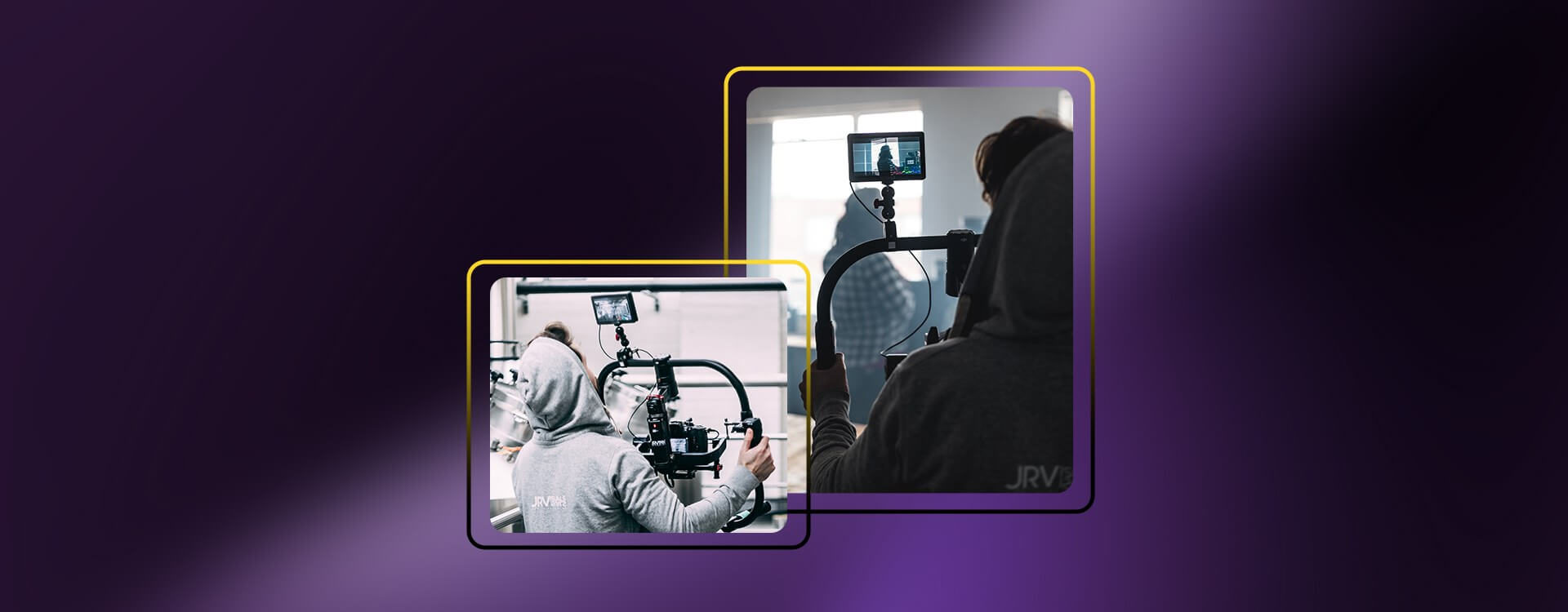Highlights
Table of Contents
Explore article topics
The Steadicam is a tool that allows filmmakers to move freely with the camera and create dynamic shots without undesired movements. And Steadicam operators need to train their physical and technical skills, and a good knowledge of film grammar is essential.
A bit of history
Movies have their grammar. Shots are part of that grammar, and some shots can only be filmed with a specific tool. Before the 1970s, you had to rig the camera to a crane or a dolly to get a steady moving shot, with all the machinery behind it. These shots were difficult to achieve since they required bulky gear and a crew to set it up.
Then, Garrett Brown entered the scene. He was a cinematographer who did not like handheld shots because he considered that human vision was not shaky. Instead, the brain compensates for our movements while walking or running to produce a steady image. From this premise, he created and tested different prototypes that could separate the camera from the operator’s body. That way, movements from the operator would not translate to the camera.
After the initial prototypes, Brown created the Steadicam and changed the history of filmmaking forever. The Steadicam did 2 things: It made it possible to film moving shots without a dolly or a crane and with only one crew member. It also allowed the filmmaker to move in tight spaces and produce shots that were impossible until then. Brown filmed a reel of 30 impossible shots, sent it to Hollywood, and the rest is history. Garrett Brown was the Steadicam operator in those films in classic films like Rocky and The Shining.
How the Steadicam works
Being entirely mechanical, the Steadicam relies upon the laws of physics to work. The operator wears a harness -the vest- attached to an extendable iso-elastic arm. A multiaxis gimbal connects the arm to the Steadicam ‘sled’, which has the camera and a system of weights (the monitor and batteries) to counterbalance the rig, making it ‘float’ independently of the operator’s movements, shakes, etc.

Don’t think that if you buy a Steadicam, you will produce good shots from the beginning. First, you need training. First, you need to develop the skill of keeping the frame and the composition by touching the post with your finger. You need to know how to operate walking backwards or running. It would help if you had an excellent physical condition for long shootings. You need a sense of anticipation to keep the frame and follow the actors. Imagine doing all this in a running shot with changes of directions, stairs, etc.
What does a Steadicam shot look like
It’s easy to imagine a Steadicam shot because it is a shot where the camera moves in space. You can track, tilt, pan, etc., and combine these movements. The Steadicam shot usually follows the actors, reveals a space, can be used for a POV shot, a low angle shot, or to make the audience feel in the middle of a scene… Let’s see some examples to illustrate this.
Rocky
The shining
The first shot in this sequence
Snake Eyes
While this is not a continuous take, you can see that you can complicate the shot as much as you want
Goodfellas
Empty London
As you see, imagination is the limit. Steadicam shots are not exactly like crane or dolly shots because they have that floating, human element. It makes them more natural, less ‘perfect’, even in the hands of the experienced operator. In low-budget scenarios, the Steadicam can substitute a dolly shot. But if the situation allows you to use a dolly or a crane because you need that shot from a narrative point of view, use them. The feeling is just different. However, a Steadicam will give you a similar shot and solve the problem on many occasions.
A tip: if you get a Steadicam, don’t use it for everything. Some filmmakers buy a new gadget and then film all the shots with that gadget. For example, many corporate videos or low-budget documentaries open with a Steadicam shot -or any other gimbal model- walking all over the place when a slow pan in a tripod would do the job without the distraction of the movement. Think about what you need to tell in your story and then decide on one kind of shot or the other.
Get unlimited royalty-free 4K footage
What types of creators use the Steadicam?
Any creator who needs moving shots will benefit from a Steadicam. Operators usually own their equipment, know it and have experience using it. Some examples of creators using the Steadicam:
-
Narrative filmmakers
no matter if you are shooting a short film or a feature, a good Steadicam operator will give you those shots in the script that need movement.
-
Documentary directors
in many documentaries, you have to be ready for what could happen next. If you don’t want shaky footage, a Steadicam will get you that shot that doesn’t have a second take.
-
Sports, TV
I am sure you have seen a Steadicam operator in a football match or other sports. As Garrett Brown says in one of his lectures, live sports can’t be faked with CGI. To get a moving shot in something as unpredictable as a sport is priceless.
-
Content creators
If you are creating content on a budget, you are filming yourself, and you want fresh shots that don’t feel staged, a small Steadicam or gimbal will raise the level of your productions.
-
Music video directors
A Steadicam is a perfect companion to film a music video. It’s ideal for choreographies and for band performances. You can move following the dynamics of the music and give the video that feeling of being there.
A quick guide to setting up your Steadicam rig
- The first step is to balance your camera and the weights. For this, make sure the camera has the same weight and accessories you will use in the shot. Otherwise, as soon as you change the camera’s weight, you will have to do it again.
- Find the balance point of the camera, mark it and attach the camera to the plate.
- Add the monitor and batteries to the lower part of the sled.
- Move and extend the posts and the weights until the center of gravity is balanced.
- Adjust the harness, attach the arm, and then the arm to the sled. Now it’s time to set up the arm until it does not move.
- Depending on the kind of shot (walking forward, backward, low-angle, high-angle), you will need to adjust the arm and change the position of the elements.
- The final step is fine-tuning until everything is balanced and ready, going back and forth through the previous steps.
The first time you do this, it will take some time. But, with practice, it will be a matter of minutes. Also, if you use a similar setup every time, the process will be easier and faster.
Dos and don’ts
Do
- Have someone to help you the first time you set up the Steadicam.
- Prepare your camera before you start balancing. Make sure you put batteries and memory cards, the lens and filters you will use, etc.
- Be patient. The first time you set up the Steadicam, it will take time.
Don’t
- Exceed the maximum weight supported by the model you are using.
- Let the sled go when you’re setting up the arm. Hold it or have your hand near it at all times.
Steadicam alternatives
A Tiffen Steadicam is expensive. It could be a good investment if you have the money and want to become a Steadicam operator. If you are a director working on a project that needs Steadicam shots and the budget is reasonable, the best thing is to hire an experienced Steadicam operator.
If you need to produce moving shots constantly and you don’t have the budget for the original Tiffen Steadicam, you have infinite options on the market.
3-axis motorized gimbals opened a new world of possibilities to DSLR and mirrorless users.
Some examples are the MOVI Pro, the DJI RS 2, etc. The difference between them and the Steadicam is that the elements are electronic, not mechanic.
The latest models incorporate electronic focus, wireless transmitters, LCD touchscreens and accessories to mount the gimbal to drones, cranes, etc.
However, they also require time to set up and master the technique. These models are lighter than the Steadicam, but the weight is on your arms, not distributed through your body. This fact makes fatigue appear sooner. For extended operation times, a dual handle will help.
For smaller cameras, a small one-hand gimbal will do the job. They are small and portable. Now, we even have Steadicams for smartphones!
If you are on a tight budget, a camera with good in-body image stabilization (IBIS) will be enough if you know its limitations.
Wrap up
The invention of the Steadicam was so unique that it became a proprietary eponym. Filmmakers use ‘Steadicam’ -a trademark name- to refer to any stabilizing camera system. Since its invention, the grammar of filmmaking has changed and expanded, only limited by the filmmakers’ imagination. Nowadays, you can see Steadicam rigs in every serious production because of their capabilities and because they are cheaper and faster than setting up a crane or dolly tracks.
Frequently asked questions
It depends on the model. A complete Steadicam rig for bigger cameras could cost between $25,000-30,000. For DSLR and small cameras, a full rig can cost around $2,500-3,000.
The Steadicam is used for moving shots, tracking shots, low-angle shots, pan, tilts… imagination is the limit with this tool.
The weight changes depending on the model and configuration. You could be carrying around 30-40 kg total with cinema cameras.
Jose Prada is a filmmaker, musician and writer based in the UK and Spain. He has won several awards with short films and commercials and has published filmmaking courses on different platforms. jrvisuals.co.uk, the production company he founded together with Rene Strgar contributes high-end stock footage to Artgrid.
Share this article
Did you find this article useful?
Related Posts
- By Josh Edwards
- 5 MIN READ
- By Artlist
- 12 MIN READ
Latest Posts
- 25 Apr
- By Josh Edwards
- 4 MIN READ
